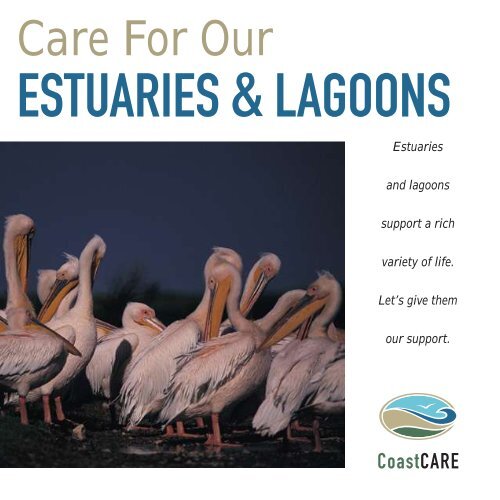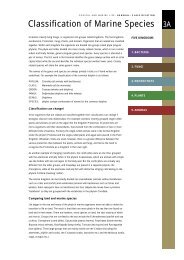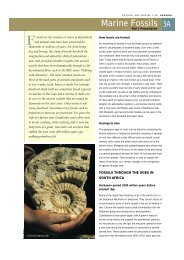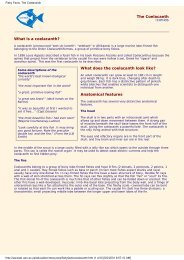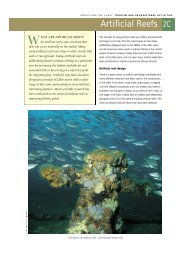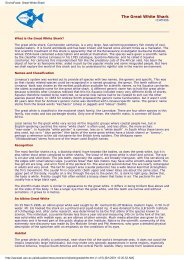Estuaries and Lagoons - South African Coastal Information Centre
Estuaries and Lagoons - South African Coastal Information Centre
Estuaries and Lagoons - South African Coastal Information Centre
- No tags were found...
Create successful ePaper yourself
Turn your PDF publications into a flip-book with our unique Google optimized e-Paper software.
Care For OurESTUARIES & LAGOONS<strong>Estuaries</strong><strong>and</strong> lagoonssupport a richvariety of life.Let’s give themour support.CoastCARE
ESTUARIES ANDLAGOONS GIVE USMUCH MORE THANWE MAY REALISE.Fresh river water flows from the mountains towards the salty sea.Where the two meet at the river mouth is a transition zone between freshwater <strong>and</strong> marine environments, commonly known as an estuary. Manyestuaries are permanently open, but others occasionally get cut off fromthe sea by a s<strong>and</strong> bar, when the river flow is low.The character of an estuary is determined by rainfall, geology <strong>and</strong> the interaction between the river water <strong>and</strong> the salt waterof the sea - each rise <strong>and</strong> fall of the tide causes changes. Also, during floods, an estuary can be transformed overnightfrom tranquil waters to raging muddy torrents. Or, when an estuary is separated from the sea by a s<strong>and</strong>bar, makingit a lagoon, it may become abnormally saline or even completely dry. These changes in character require specialadaptations in the organisms that inhabit estuaries. Those that are able to overcome the obstacles can thrive on thefood provided by both river <strong>and</strong> sea.
Along with rainforests <strong>and</strong> coral reefs, estuaries are amongst the most productive ecosystems on earth, supporting aparticularly large number of species within a relatively small area.<strong>Estuaries</strong> are substantial producers of organic matter, which enriches our seas by promoting growth <strong>and</strong> contributingsignificantly to the productivity of continental shelf waters. They are also important as nurseries for small fish <strong>and</strong> as richfeeding grounds for many types of birds. Around the edges of some of our estuaries, estuarine wetl<strong>and</strong>s such as salt marshes,mangrove swamps <strong>and</strong> reed-beds are found. These wetl<strong>and</strong>s are extremely productive systems, providing the basic buildingblocks of the aquatic food chain.<strong>Estuaries</strong> <strong>and</strong> lagoons are sought-after recreational areas, catering for a wide variety of activities, including swimming,angling, powerboating, sailing, hiking <strong>and</strong> bird-watching. As such they are an extremely valuable tourist attraction bringingmuch-needed revenue to our country.Some estuaries <strong>and</strong> lagoons have proved suitable for aquaculture, for example, the Knysna lagoon where oysters are cultured,thus providing employment for numerous locals. Certain estuarine systems are used as harbours, such as Richard's Bay <strong>and</strong>Durban Bay, which are important as the basis of both commercial <strong>and</strong> tourist activities.
HOME TO MANY FISH AND UNUSUAL UNDERWATER CREATURES.As sheltered inlets along the otherwise harsh, wave-washed <strong>South</strong> <strong>African</strong> coast, estuariesare the perfect nursery for juvenile fish, spawned offshore, to grow <strong>and</strong> mature beforereturning to the open sea to live <strong>and</strong> breed. <strong>Estuaries</strong> are therefore vital to bothcommercial <strong>and</strong> recreational anglers.As many as 100 species of fish are wholly or partially dependent on <strong>South</strong> <strong>African</strong>estuaries, while up to 400 species frequent estuaries at some time of their lives. Commonestuarine fish species include the mullet, spotted grunter, steenbras, stumpnose <strong>and</strong> kob.Other smaller species are the s<strong>and</strong> goby, glassies, needlefish <strong>and</strong> pipefish.The Knysna Seahorse
Another unusual fish species is the legendary Knysna seahorse, that occurs in the Knysna, Swartvlei, Keurbooms <strong>and</strong> Klein Brakestuaries along our southern coast. The Knysna seahorse is best known for its unique brooding habit: The female deposits her eggsin the male's brood pouch where fertilisation takes place. The male seahorse then carries the growing embryos in his pouch, fromwhich up to 120 juveniles emerge one by one after 45 days. The male even experiences contractions, similar to a female givingbirth, to help expel the little ones. To stop itself from being washed away by tidal currents, the seahorse coils its tail around aquaticplants like eelgras.On the bottom of estuaries <strong>and</strong> lagoons a wonderful variety of creatures spend their lives in the sediment, some making deepburrows. In the estuary's muddy upper reaches, large populations of worms, crustaceans <strong>and</strong> molluscs are to be found.Here, the mud-prawn predominates - an essential part of the estuarine food web. Closer to the s<strong>and</strong>ier mouth, a differentcommunity occurs, including the s<strong>and</strong> prawn, the razor clam <strong>and</strong> pencil bait.Mud PrawnMud-skipper
ESTUARIES AND LAGOONS ARE BIGATTRACTIONS FOR A VARIETY OFBIRD SPECIES.Grey HeronThese include sea birds <strong>and</strong> waders as well asspecies such as the red-knobbed coot that feedon water-weed, <strong>and</strong> fish-eaters like pelicans,cormorants, kingfishers <strong>and</strong> herons. The beautifulWhiskered Ternpink <strong>and</strong> white flamingo is one of thelargest birds found in lagoons. Thereare in fact two species of flamingo: thelesser flamingo which is a filter-feeder,Malachite Kingfishersieving water through its moustachelinedbeak to catch plankton, <strong>and</strong> thegreater flamingo, which feeds by treading the mud in a circular movement<strong>and</strong> then sieving through the muddy water to catch the invertebrates thatemerge from the disturbed mud. This leaves circular marks, much like theimprints of tyres on the s<strong>and</strong>.Greater FlamingoWaders mostly breed in the Arctic regions during the brief summer, <strong>and</strong> aswinter sets in, they migrate southwards to destinations along our coastlineCurlew S<strong>and</strong>piperduring our summer months. Visitors from as far afield as Greenl<strong>and</strong>, Siberia <strong>and</strong>Sc<strong>and</strong>inavia end their journey at Langebaan lagoon, which supports up to55 000 waders annually - over 40% of the total wader population of thesouth-western Cape. Many other estuaries along our coast are also destinations inthis annual migration. Here the birds can rest <strong>and</strong> fatten up for the return journey.Pied Kingfisher
A DIVERSITY OF WATER-LOVING PLANTS INCLUDINGSALT-MARSH PLANTS, MANGROVES, EELGRASS, REEDSAND AQUATIC WEEDS THRIVE IN ESTUARIES.REEDS AND TALL GRASSES often line the banks at the head of anestuary where the level of salt in the water is low. Here they form thickbeds that help to hold the banks together, <strong>and</strong> also act as filters bytrapping rain-borne silt <strong>and</strong> using the nutrients in the water tricklingthrough them. In this way, reed-beds contribute to keeping estuariesclean <strong>and</strong> preventing over-fertilisation.Harvesting NcemaMANGROVES are tropical <strong>and</strong> subtropical trees that grow in theintertidal zone of estuaries from Kosi Bay to the Nahoon River in theEastern Cape. There are three common species: the white mangrove,which extends almost to East London, <strong>and</strong> the black <strong>and</strong> red mangroveswhich grow as far south as the Transkei.As the only trees adapted to living in salty water, Mangroves face theproblem of being rooted in oxygen-deficient, water-saturated soil, wherewithout enough air they are in danger of being drowned. To overcomethis, they have developed special aerial roots that stick out of the mud.Some are pencil-shaped, others are knobbly elbow-like projections,while yet others have strut-roots that grow high on the trunk <strong>and</strong> serveboth as a means of absorbing oxygen <strong>and</strong> as stabilisers to the tree.Associated with mangroves is a wide diversity of plants <strong>and</strong> animalsthat play an integral role in the estuarine food chain. Mangroves addlarge quantities of dead leaf material to an estuary <strong>and</strong> this, when itdecomposes, provides nutrients for other organisms in the food chain.Mangrove estuaries are also important feeding <strong>and</strong> breeding groundsBlack Mangroves
Salt-Marsh Vegetation
for fish <strong>and</strong> other marine life. Furthermore, they serveas protection for shorelines against erosion as theyhave a great capacity for trapping silt - their rootletsform a thick web that stabilises the mud banks <strong>and</strong>cleanses the water of silt.FLOWERING PLANTS colonise the s<strong>and</strong> or mud flats<strong>and</strong> many of these, such as the attractive <strong>and</strong> delicatesea lavender, can tolerate extreme saline conditions.Cord grass, which occurs on the mud banks, also formsa distinct zone in many estuaries, <strong>and</strong> quickly stabilisesthe mud. Higher up the banks, a variety of aquatic orsemi-aquatic plants like the glassworts are found. Marshglassworts are very unusual <strong>and</strong> have fleshy stems withno leaves.SUBMERGED AQUATIC PLANTS like the eelgrass, arerooted in the muddy or s<strong>and</strong>y bottoms of estuaries.They too form a distinct zone <strong>and</strong> are only exposed atthe lowest spring tides. They provide food <strong>and</strong> shelterfrom predators for many juvenile fish species. Othersubmerged aquatic plants, such as the 'fonteingras',are also found in the more sheltered <strong>and</strong> less saltywaters; while the sheltered pools of the shallow mudflats <strong>and</strong> lagoons are home to many species of larger algae.Kosi Bay Fish TrapsAND A HAVEN FOR THINGS OF YESTERYEAR.Along our coastline, some traditional indigenous fishingmethods are still in practice alongside <strong>and</strong> in sharpcontrast to the modern way of doing things. This is thecase in the Kosi Bay estuary, where there is large-scaletraditional use of fish <strong>and</strong> related organisms. Designedto trap fish coming in on the high tide <strong>and</strong> to prevent themfrom returning to sea as the tide recedes, the Kosi Bayfish traps have remained virtually unchanged for centuries,<strong>and</strong> are still in full operation today.While most of the existing traps in other areas are beingreplaced by gillnets, this ancient method of fishing existshere along with recreational angling <strong>and</strong> gillnetting. Thisis a prime example of joint conservation management,where sustainable traditional practices are allowed tocontinue unhindered.
THE IMPACT OF HUMAN ACTIVITY. THE THREATS ARE NUMEROUS.As estuaries are where sea <strong>and</strong> river meet, they are also the place where variousdifferent natural forces interact <strong>and</strong> are therefore particularly vulnerable to harmthrough man's actions. Furthermore, compared to many other countries our estuariesare small in size <strong>and</strong> few in number, <strong>and</strong> many of these have already been extensivelyimpacted on by man.A major threat to our estuaries is the deterioration of their catchment areas through, for example, the damming of rivers <strong>and</strong>removal of water, which results in a reduced input of freshwater as well as altered river flow patterns. This results in flood events (which arevital to the health of our estuaries) becoming smaller <strong>and</strong> less frequent, which in turn reduces the scouring of sediment from the estuary, sothat it is not flushed out properly <strong>and</strong> could start to silt up. Over time the estuaries, starved of water, become shallower <strong>and</strong> more saline.Properties alongside estuaries are very popular development sites with high property values. However, development here meansthat the important shallow waters on the estuary margins are often lost when filled in with rubble <strong>and</strong> soil, or converted intomarinas. Estuary mouths then have to be breached prematurely to prevent flooding of buildings situated too close to the water.This dramatically affects the dynamic nature of the estuary.Other negative impacts arise from agricultural practices that may lead to soil erosion; roads or railways which intrude intofloodplains; the 'fixing' of mouths with retaining walls; various forms of pollution from l<strong>and</strong> or sea; <strong>and</strong> dredging to removeexcess sediment build-up.
MANAGING ESTUARIES AND LAGOONSTO EVERYONE’S ADVANTAGE.The answer to the many threats that face our estuaries lies in finding a balance between the often conflicting interests ofdevelopers <strong>and</strong> conservationists. With the growth of human populations <strong>and</strong> the increase in urbanisation <strong>and</strong> industrialactivities, the development of certain estuarine areas is both inevitable <strong>and</strong> necessary for the economic well-being of ourcountry. Protection of these areas is also essential if the natural resources provided by estuaries, <strong>and</strong> the quality of humanlife near them, is to be maintained.Although this task may not be an easy one, much can be done to prevent insensitive misuse of our estuaries <strong>and</strong> lagoons:• A holistic approach to river catchment management is thebest option, because the overall health of an estuarydepends on factors up <strong>and</strong> down the river.• Sound l<strong>and</strong>-use planning adjacent to estuaries <strong>and</strong> lagoonsshould be promoted to enhance the aesthetic appeal of the area,as well as to provide a refuge for wildlife from human pressure.In zoning these areas, the ecological requirements <strong>and</strong> thecarrying capacity of the estuary should be taken into account.• Development should be set back from estuary banks toallow for a vegetated buffer strip.• Because sedimentation can cause extensive harm toestuaries, it should be prevented as far as possible.• The deliberate opening <strong>and</strong> closing of estuary mouthsshould be avoided, as this could have a severe short <strong>and</strong>long-term impact.• Bridges, jetties <strong>and</strong> other fixed structures should bedesigned <strong>and</strong> sited in such a way as not to resist waterflow circulation.• All activities that alter natural water levels, flow patterns<strong>and</strong> drainage, should be avoided. Mangrove systems, forinstance, are very sensitive to altered salinity levels.• No form of pollution should be allowed to enter an estuaryvia sea or river, including pollutants from industrial <strong>and</strong>municipal waste water <strong>and</strong> offshore oil spills.• Because estuaries <strong>and</strong> lagoons are home to so many uniquespecies, we should make every effort to protect these plants<strong>and</strong> animals.• As dredging may have severe physical, chemical <strong>and</strong>biological impacts on estuaries, applications for dredgingshould be carefully considered.• Access to estuaries <strong>and</strong> lagoons should be well managedto limit the effects of trampling <strong>and</strong> recreational activities,<strong>and</strong> no vehicles should be allowed.• Compatible recreational use of estuaries should beoptimised, with due consideration given to the ecologicalrequirements <strong>and</strong> the carrying capacity of the estuary.
The more aware the public becomes of the importance of conserving ourestuaries <strong>and</strong> lagoons, the better they can be protected. You can help bywatching out for any possible threats to estuaries <strong>and</strong> lagoons in yourarea, <strong>and</strong> by keeping in contact with your local conservation authority.For more information, please contact:CoastCARE, The <strong>Coastal</strong> Management Office, Department ofEnvironmental Affairs <strong>and</strong> Tourism, Private Bag X2, Roggebaai 8012,Cape Town, <strong>South</strong> Africa. e-mail: czm@sfri.wcape.gov.zaTel: +27 (0)21 402-3208 Fax: +27 (0)21 418-2582PHOTOGRAPHIC AND ILLUSTRATION ACKNOWLEDGEMENTS: Western Cape Nature Conservation, Sea Fisheries,Hein von Horsten, Roger de la Harpe, Claudio Velasquez, <strong>and</strong> George Branch.DESIGN: Runette Louw <strong>and</strong> Jenny Young EDITOR: Vanessa Rousseau PROJECT CO-ORDINATOR: Kobie BredenkampCOASTAL MANAGEMENT OFFICEDepartment ofEnvironmental Affairs<strong>and</strong> Tourism


